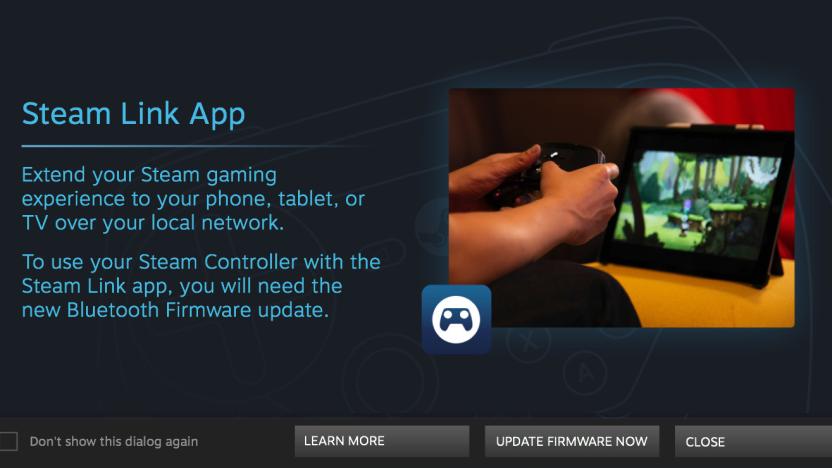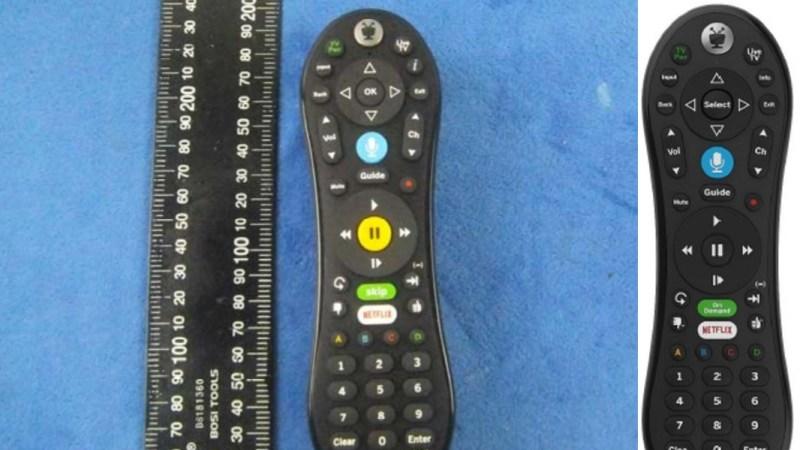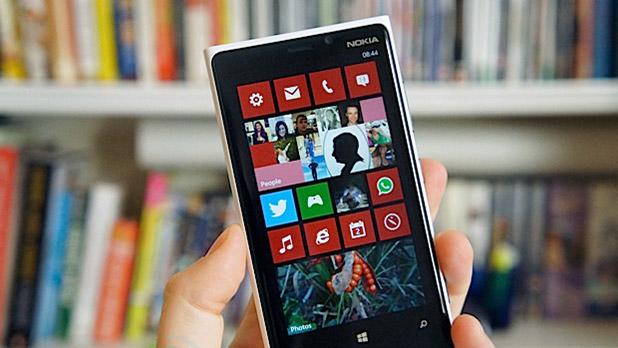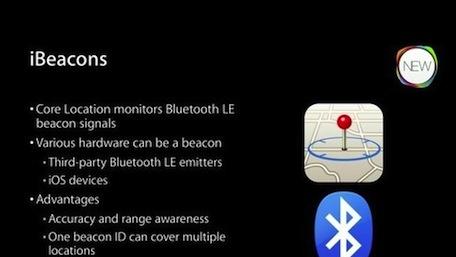BluetoothLowEnergy
Latest

Valve switches on Steam Controller's mobile connection in beta
Valve's latest beta client activates the Steam Controller's Bluetooth Low Energy function -- a necessary feature if you want to use the gamepad to play on a mobile device in the near future. If you'll recall, the company recently announced that Steam Link will be able beam games to the dedicated iOS and Android apps it's releasing during the week of May 21st. That means you'll soon be able to play on a phone, tablet or TV, so long as it's on the same 5GHz network as the host PC or it's connected to the computer via Ethernet cable.

TiVo's voice-controlled Bluetooth remote has a Netflix button
The TiVo peanut-style remote has only changed slightly over the years, but ZatzNotFunny points out that a new revision is close to release. Labeled S6V, this Bluetooth Low Energy (BLE) connected remote popped up in FCC filings, while a clearer image appeared in an earlier leak along with a trademark for TiVo Bolt Vox and TiVo Mini Vox. TiVo will hardly be the first company to put a microphone inside its remote, as the Apple TV control is built around Siri and even Comcast has a version already available. The manual included in the filing describes a two-button pairing process with the TiVo and back buttons, for the company's first Bluetooth unit since the TiVo Slide keyboard-equipped remote.

Google's Eddystone serves up location-based info via Bluetooth beacons
Using low-energy Bluetooth beacons to serve up location-based info to customers isn't a new development. We've seen more than a few implementations of Apple's iBeacon tech. Google has a new project that employs a similar setup, and it's called Eddystone. How does it differ from Apple's Bluetooth initiative? The effort is a "new and open format" that "anyone" can implement. In addition to working alongside a mobile app to beam info to your phone or tablet when you're in a specified location, Eddystone can also broadcast a URL when an app isn't an option. Rather than missing out, a company can choose to send a web link instead. And it works with both Android and iOS devices, too. There are also two location options, meaning developers can choose one of two APIs that will either find and ping a nearby beacon (like in a museum) or send info when you visit a specific location (e.g., latitude/longitude).

Nokia Black update to add Bluetooth LE across entire WP8 Lumia range
Bluetooth low energy compatibility arrived on select Nokia Lumia models (520, 620, 625 and 720) through the Amber update, but now it's making its way to the rest of the line. A new FAQ entry on Espoo's website has confirmed that the feature will come to all devices in the range (even the more high-end ones) via the upcoming Lumia Black update. The Bluetooth 4.0 mode mode uses less power than traditional Bluetooth data connections, and its arrival will allow all Lumias to connect with accessories and other gadgets that use the technology exclusively. Nokia has yet to reveal when Black will be released, but we'll update you faster than a Bluetooth transfer as soon as we find out.

iOS 7 iBeacons: An unsung feature with immense promise
While the world is getting up to speed on iOS 7's more visible features like Control Center and the dazzling parallax effects, there's one feature that hasn't gotten a lot of attention -- iBeacons. TidBITS author Michael Cohen wrote a great piece this week that talks about the feature and what it can do for iOS device owners in the future. iBeacons was just a word on a slide at WWDC 2013, but as Cohen points out, it has the potential to provide some amazing functionality. To quote Cohen, "Apps can use iBeacons to answer the question 'Where am I?' not in terms of a location on a map, like GPS does, but in terms of where the device is relative to another device. Specifically, where it is relative to another device acting as an iBeacon." An iBeacon is a radio that can be placed anywhere, and when an iOS device gets near it, it can estimate how far apart the device and iBeacon are. Any iPhone 4S or later, and any third-generation iPad or later, has the ability to be an iBeacon through the use of Bluetooth 4.0 and Bluetooth Low Energy (BLE). As Cohen explains it, BLE devices are battery-friendly and can run for weeks without recharging. So how could they be used? Well, a store could set up iBeacons in each department or aisle, so you could use a store directory app and get in-store directions to something you're looking for (are you listening, Home Depot?). Museums could offer tour apps, and Cohen even imagines a future version of Find My iPhone that would work inside a house, finding that iPhone that slipped between couch cushions. Third-party standalone iBeacon devices will start at about US$100 each, and Cohen posits that the price may drop quickly and significantly due to the popularity of iOS. Right now, there's really nothing that takes advantage of iBeacons, but this is a capability of iOS 7 that is just waiting for the right app to come along.

Casio's new G-Shock watches pack Bluetooth, music remote control
Newcomers like Pebble might be the current darlings when it comes to connected watches, but it doesn't mean that established players are standing still. Back at CES, Casio showed a G-Shock watch with Bluetooth (GB-5600A) capable of receiving calls and text-message notifications (with sound and vibration), plus automatic time updates from an iPhone. Today the company announced a pair of G-Shock watches (GB-6900B / GB-X6900B) with Bluetooth 4.0 LE that extend the existing functionality to select Android handsets. In addition, both watches feature music remote control (via AVRCP, presumably) and the ability to set alarms and timers from Casio's companion smartphone app. Battery life is a pretty impressive two years (with 12 hours of Bluetooth use per day) on a single CR2032 battery. The GB-6900B and GB-X6900B will be released in Japan on September 21st for 18,000 yen (roughly $187) and 20,000 yen (roughly $208) respectively. All that's needed now is a retro-looking Databank or calculator watch with Bluetooth, right, Casio?

August: the beautiful, Yves Behar-designed $199 smart lock
The home automation market is really starting to take off, and surprisingly, it's door locks that are proving to be one of the biggest areas of interest. Established home security companies like Kwikset and mobile carriers (via unnamed OEMs) are working to combine smartphones and deadbolts, while startups like Smart Knob are using offline technology to simplify vacation rentals. August, the brainchild of Yves Behar and Jason Johnson, combines elements of both approaches and does so with Behar's typical flair for stunning design. The primary way of unlocking an August-equipped door is through an app that pairs with the stylish mechanism via Bluetooth. But it skips out on the direct internet connection, which could leave it more vulnerable to hacks. Instead, it passes all necessary online communications through the paired phone or tablet. In fact, it's capable of operating without an internet connection at all, since it relies on algorithmically generated keys, similar to a secure ID token. Those "keys" are assigned to specific devices, that also have the app installed, which are identified via Bluetooth LE. Each lock is synced up with Augusts' servers and attached to a unique account that you manage through the companion app. And, even if the batteries die, you can still use the old standby: an actual key. %Gallery-189729%

Mosoro releases its Bluetooth LE sensors and SDK for VIP appcessory developers
Since we last heard about Mosoro's Lego-brick sized Bluetooth LE modules, they've changed their names, picked up another member and are now making their way to iOS app developers. The 3D-Motion's got an accelerometer, gyroscope and magnetometer, while the Enviro measures temperature, humidity and barometric pressure. New to the team is Proximity, useful for triggering location-based apps and tracking motion for creating alerts. All three rechargeable Bluetooth low energy sensors have "shake-to-wake" support, an RGB "glow-cap" for notifications and a humble programmable button. They are expected to hit retail in fall 2012, but "VIP" app developers can grab them now, as well as the SDK which simplifies iOS Bluetooth integration. Got the ideas and inclination to become one of Mosoro's "rock star app-developer partners?" Then go sign up on the website and see if you make the VIP grade.

MetaWatch offers iPhone compatibility in new developer kit
So, you didn't get signed up to get one of the first Pebble watches on Kickstarter? Well, you have a fallback plan now. MetaWatch, a spinoff of watchmaker Fossil, has released a new version of its self-named watch in developer kit format that specifically uses Bluetooth 4.0 (found in the iPhone 4S and iPad) to communicate to your device without being a drain on the watch or phone battery. This isn't exactly a mainstream smartwatch ... yet. It's really targeted to developers who can write their own apps to take information from the iPhone and display it on the watch, but hopefully if enough devs get excited about MetaWatch you'll be able to purchase one without the need to be a programming genius. The watch is available immediately from TI's eStore (it uses a low-power microcontroller from TI) and MetaWatch's store page for US$199.

TI promises 33 percent drop in power consumption with new Bluetooth system-on-chip
Bluetooth may enable a whole host of different wireless possibilities, but that often comes at the expense of one important factor: battery life. Texas Instruments is hoping to make that slightly less of an issue with its new CC2541 Bluetooth system-on-a-chip, however, which promises a 33 percent reduction in power consumption compared to its previous CC2540 SoC. That's done without changing the configuration of the chip itself, which means manufacturers will be able to switch to the new design without making any major changes to their own devices -- it's intended for use in everything from sports and fitness gadgets to home automation equipment. The full rundown of specs can be found in the press release after the break.

Apple reportedly stepping up its connectivity game, wants to be the center of your wireless universe
Apple is purportedly readying a new certification chip for accessory makers that will allow wireless access and connectivity to that pile of iOS devices you're hoarding. Announced during an accessory manufacturer's conference in China, the new chip could possibly allow connections across AirPlay, Bluetooth and WiFi. The Cupertino crew hope that this will encourage even more iOS-friendly add-ons and docks to market. According to Macotakara, Apple apparently added that it's working on support for AirPlay over Bluetooth, presumably bringing with it some improved battery longevity, and tying into the new low-powered Bluetooth 4.0 found on the iPhone 4S. Well, you know us, we always love seeing new iPad accessories. Update: An anonymous attendee has got in touch to tell us that the authentication chip is low-cost and faster update that doesn't bring any new features not already seen on current chips. Our mole added that Apple didn't directly announce any plans to extend AirPlay functionality to Bluetooth.

Freescale Home Health Hub wants to usher in the era of connected medical devices
Freescale has its little silicon hands in all sorts of things: e-readers, smartphones, tablets, even refrigerators. Now the manufacturer is looking to make a dent in the healthcare industry with a connected platform called Home Health Hub (HHH). The i.MX28-based HHH isn't an actual product, but a reference platform for others to build on. The ARM9 processor is connected to a host of networking interfaces, including WiFi, Bluetooth (as well as its low-power implementation), Zigbee, sub-1GHz and Ethernet. The Hub is supposed to be just that, a central point for connecting various medical devices like blood pressure monitors or glucometers that then feeds data to a tablet. Developers and other interested parties can get their hands on the reference platform from Digi International as the iDigi Telehealth Application Kit for $499. Check out the full PR after the break.

Casio shows Bluetooth Low Energy watch prototype, awaits Bluetooth Low Energy phones
Sony Ericsson, Citizen, and others have been taking occasional shots at integrating Bluetooth into wrist-bound baubles for several years now, but the problems have been pretty obvious -- Bluetooth wasn't really optimized to transfer nibble-sized chunks of information while sipping almost imperceptible amounts of power, so you end up with a watch that dies in hours or days rather than years. That's where Casio comes into play, showing off a prototype watch here at CES that makes use of Bluetooth Low Energy to connect to your phone and keep you abreast of calls and emails without the hassle of pulling the handset out of your pocket (or, worse yet, your belt-mounted holster). You can also silence alarms just by tapping on the watch, get your time synced, and generally look awesome while doing it -- if it were a production unit, that is. Problem is that there aren't any phones on the market with Bluetooth 4.0 support just yet, but Casio's confident enough that they're in the pipeline to say that they want to product their first BLE-enabled retail watches in 2011. The company is claiming two years of battery life off a single coin cell assuming twelve hours of use a day... so yeah, the benefits for this type of product are pretty clear. Follow the break for the full press release.

Bluetooth 4.0 with low energy (almost) finally ready to roll
Molasses, snails and glaciers: none are slower than an organization developing a new wireless standard. The Bluetooth Special Interest Group (SIG) is no exception -- it's been nearly three years since it announced it would roll Wibree into Bluetooth and four months since it made Bluetooth 4.0 official, but still no dice. This week, the SIG says the low-power specification is ready for action, its minutiae finalized. However, fine print in the org's press release disagrees. The main reason for Bluetooth 4.0 was to include lower power devices, but that all-important integration is still pending a "before June 2010" completion date. That means we still won't see Bluetooth-toting cats till the end of the year, and we have no idea what SIG has accomplished in the meanwhile. Press release after the break.

Bluetooth 4.0 devices to make the scene later this year
We were glad to see Bluetooth low energy actually added to the Bluetooth 4.0 spec, but of course the question remained: when are we going to get our hands on it? By Q4 this year, apparently -- at least according to the Bluetooth SIG. But don't expect any dramatic changes in battery life for most of your gadgets: while the low energy spec introduces connectivity to a host of lower-power devices that have in the past relied on proprietary technology (such as watches, pedometers, and cats), your traditional Bluetooth devices, such as phones and laptops, will consume roughly the same amount of power. Indeed, the low energy spec is merely throwing smaller devices (with smaller amounts of data to transfer) in to the mix: if you want Trans-Siberian Orchestra to sound as glorious as ever on your wireless headphones, you'll need to push as much data (and hence draw as much power) with version 4 as you would with version 3. If you've ever heard "A Mad Russian's Christmas," you'd know what we're talking about.

Broadcom announces Android support, three-pack of chips to make your phones more awesome
Chip maker Broadcom has unveiled no fewer than three new mobile-themed hunks of silicon this week in preparation for MWC in just a few days' time. You ready for this? Alright, first up we've got the catchily-named BCM20751, which performs the rather ordinary tasks of GPS, Bluetooth, and FM radio management but also throws in an audio processor to offload some work from the phone's primary CPU, which the company says can reduce battery consumption enough to improve playback time by up to 100 percent in some situations. Next up, we've got the BCM4751, a GPS receiver that Broadcom's confident is going to set a new benchmark for mobile location-based services; a complete setup takes less than 30 square millimeters of precious board space and is claimed to be a guru at picking up weak signals all the while sipping power. Finally, the BCM2049 supports Bluetooth 2.1+EDR, FM (both transmitting and receiving), and Bluetooth Low Energy -- something that was recently adopted for standardization in Bluetooth 4.0. All three should be on display at the show next week. That's not all, though -- the company is also announcing comprehensive support for Android across much of its product range, which seems like a pretty prudent business decision all things considered.

Bluetooth 4.0 finally rolls low energy tech into a shipping standard
Bluetooth low energy and its predecessors (think Wibree) have been in the pipe for ages now, but we might actually see this tech take off en masse for the first time now that the Bluetooth SIG has officially added it into a release: 4.0. While Bluetooth 3.0 was all about high energy with the introduction of WiFi transfer, 4.0 takes things down a notch by certifying single-mode low energy devices in addition to dual-mode devices that incorporate both the low energy side of the spec plus either 2.1+EDR or 3.0. In a nutshell, the technology should bring a number of new categories and form factors of wireless devices into the fold since 1Mbps Bluetooth low energy can operate on coin cells -- the kinds you find in wristwatches, calculators, and remote controls -- and the SIG's pulling no punches by saying that "with today's announcement the race is on for product designers to be the first to market." Nokia pioneered Wibree, so you can bet they'll be among the frontrunners -- bring it, guys.

Texas Instruments CC2540 promises ultra-low energy Bluetooth
Texas Instruments is pretty chuffed with itself right about now, as it's prepping to demonstrate a swell-sounding new system-on-chip that takes Bluetooth connectivity to the extreme reaches of low energy consumption. About to be shown off in Munich tomorrow, the new CC2540 takes up a measly 6mm-squared of real estate, and is said to be able to operate for more than a year on a single button cell battery. With the reduced physical size and embedded Flash memory, this should be easier to install and update as necessary too. Considering the battery-draining ways of current Bluetooth tech, such claims sound preposterously awesome, but we'll keep our giddy enthusiasm in check until early next year when samples will begin rolling out. For now, you can check out the older video below 'splaining the prospective benefits in more detail. Read - Texas Instruments press release Read - Bluetooth low energy webpage Read - Video explanation of Bluetooth low energy

CSR demonstrates Bluetooth low energy transfer
We know you're not really down with digesting any more catchphrases, but the technology formerly known as Ultra Low Power Bluetooth / Wibree is now being dubbed Bluetooth low energy. Now that we're clear on nomenclature, you may be thrilled to know that CSR showcased its recently unveiled BlueCore7 dual mode (Bluetooth low energy and Bluetooth v2.1) chip at a Bluetooth SIG Medical Working Group meeting. According to onlookers, the handset was able to transfer data to another nearby mobile using just 3 frequencies rather than 32, resulting in an unquantifiable decrease in power consumption. Sounds like a winner on the surface, but we have this weird feeling that mass adoption of this tech is like, years away.









